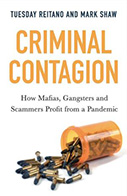Criminal Contagion: How Mafias, Gangsters and Scammers Profit from a Pandemic

Authors: Tuesday Reitano and Mark Shaw
Publisher: Hurst and Company, 2021. 320 pages.
Reviewer: Vesna Markovic ǀ June 2022
The COVID-19 global pandemic has caused an unprecedented level of disruption to our daily lives. Aside from major risks to our health, we have lived through lockdowns, border closures, curfews, and disruptions of the supply chain. Even in 2022, there are still many ongoing issues due to staff shortages and continued strain to our healthcare system.
But did these disruptions also have the same impact on criminal organizations? In the book Criminal Contagion, Tuesday Reitano, Deputy Director of the Global Initiative Against Transnational Organized Crime, and co-author Mark Shaw, Director of the Global Initiative Against Transnational Organized Crime, aim to answer this question. The book provides a historic background on the burgeoning nature of transnational organized crime from the Cold War era to the current global pandemic. They give evidence of the issues that the pandemic has posed to groups and how they have adapted. Not only have groups been able to weather the storm, but through their innovative nature, in many cases, they have been able to adapt to the new and changing pandemic environment.
For some criminal industries, border closures and lockdowns led to changes in methods used by organized criminal groups. Some of these shifts occurred in illegal drug markets. With the closure of nightclubs and bars due to the implementation of curfews, the use of so-called “party” drugs like cocaine and Ecstasy decreased, while use of marijuana, heroin, and fentanyl increased. Border closures and the cessation of international flights also stopped drug couriers from being able to operate. Even street dealers were unable to operate easily during lockdowns, but were soon back up and running while taking necessary precautions. An informal survey in the U.K. noted that street dealers wore personal protective equipment (PPE), make contactless deliveries, and even disinfected cash.
These closures also had an impact in other areas, such as human smuggling. While some smugglers abandoned their customers, others opted for alternative, and potentially more dangerous, routes. Border closures also led to humanitarian crises because refugees looking to escape their dire situations were, in many cases, stuck in makeshift camps because borders were closed. This even created trafficking routes in countries that did not have a need for such criminal enterprises. Not only have border closures had severe impacts, but the strict lockdowns played a role as well. These lockdowns, however, increased certain criminal activities, such as illegal mining. In Peru, for example, when lockdowns were enforced, police and military withdrew causing an increase in illegal mining of gold.
Although there were disruptions due to lockdowns and closures, it also presented new opportunities for criminal groups on which to capitalize. Given the global lockdowns, many people worked from home, and kids of all ages were online for school. This, of course, led to an increase in e-commerce and e-criminals. The book suggest that cybercrime is estimated to have seen the highest increase in profits during this time. People working from home, with their networks often less secure than at work, were targeted by various cyber scams. At the height of the pandemic, hospitals around the world fell victims to ransomware attacks.
Groups also branched out into various other industries. At the beginning of the pandemic, finding face masks was nearly impossible. This allowed groups to diversify and provide these critical supplies. This included the sale of facemasks, sanitizers and other types of PPE, much of which were not up to standards. Even fake testing sites have been set up to capitalize on shortages of test kits.
Criminal organizations also stepped in where governments failed to provide supplies and services. In some cases, they got involved to make money, such as the Yakuza offering to help disinfect the Diamond Princess cruise ship, which was quarantined in February 2020. In other cases, groups opted to assist communities in which the government had not extended services. The family of former Sinaloa Cartel leader Joaquin “El Chapo” Guzman-Loera handed out food boxes and water emblazoned with El Chapo’s face to communities in need in Mexico, leading some to call them “Chapo’s provisions.” Other groups in Mexico, such as the Jalisco New Generation Cartel, the Gulf Cartel, Los Durango, and Los Viagras were also distributing money and food to communities. These signs of good will have been long used by groups to maintain support of communities.
Although the reach of some criminal enterprises remained the same or increased, some industries did not fare as well. The notion that the pandemic was allegedly linked to a wet market in Wuhan, China – whether true or not – made a significant impact on the illegal trade of wildlife. A survey conducted in 2020 in several Asian countries showed a large increase in the number of people who were unlikely to eat wildlife products in the future. The illegal trade of wildlife was also impacted by lockdowns, cessation of air travel, and greater scrutiny at borders. The greater scrutiny at borders led to an increase in seizures of illegal wildlife. In addition, the number of rhinos poached in Africa in the second quarter of 2020 – less than 50 – was a substantial drop from the second quarter in 2018, which had nearly 200 poached rhinos.
The criminal justice system, as a whole, was also severely impacted during the COVID pandemic. Police and other first responders were considered essential workers and were, therefore, put “in the viral firing line” (p. 151). Due to quarantine requirements, police departments in multiple countries, including Austria, Brazil, Colombia, France, Honduras, India, Kenya, Mexico, Namibia, Northern Ireland, Pakistan, Puerto Rico, Russia, and Uganda, were forced to shut. In Kenya, for example, gangs used these lockdowns and diverted police attention to fight for control of more territory, as well as to loot and rob. I
n many countries, police were also enforcing lockdowns, which of course pulled many officers away from fighting transnational organized crime (except where the two directly intersect). In Italy, for example, a wanted mafia boss from the Calabrian ‘Ndrangheta was arrested–not for criminal activity, but for violating the strict lockdown restrictions put in place due to the sharp rise in deaths in Italy due to COVID. In some cities, since police were quarantining, gangs controlled the streets. In favelas in Brazil, gangs took to the streets, playing recorded messages that warned people to take the lockdown seriously and that those caught on the streets would be dealt with.
Many courts went on lockdown during the pandemic, which caused a delay in trials and the meting out of justice. Court cases were moved to an online format, and prisons were hit hard in particular. Due to the ways in which inmates are housed – and unable to isolate and maintain physical distance – COVID cases were rampant. Overcrowding in prisons made the issue even more dangerous. In many countries, outbreaks of COVID led to deaths of inmates and forced some systems to release large numbers of prisoners. The Democratic Republic of Congo (DRC), for example, released at least 12,000 inmates. Countries like Italy also released inmates early due to the pandemic. There was an outcry as some members of the mafia, including one who directed bombings that killed two carabinieri in 1994, were released.
Reitano and Shaw provide an in depth look into how criminal enterprises make money exploiting global pandemics like COVID-19. Many examples are given highlighting the changes and innovations made by groups around the world. With all the examples of how criminal groups exploited the pandemic to make money, the final chapter, “Prevention, Treatment and Cure,” is slightly lacking in the depth necessary to challenge this threat. The transnational organized crime landscape is ever changing, and many groups have been able to create innovative ways to avoid the cessation of their business. It is truly hard to determine all of the impacts that the COVID-19 pandemic has had on the underground economy, as the pandemic is still ongoing even in 2022. The book provides a solid foundation of research on the topic, and it is certainly in a good position to have a second edition in the post-pandemic atmosphere.
Dr. Vesna Markovic, Professor and Chair, Justice, Law and Public Safety Studies, Lewis University.


